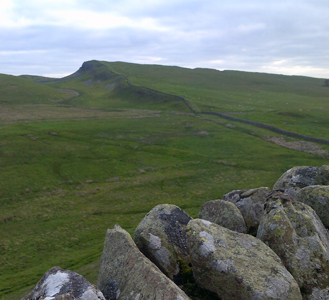Hadrian’s Wall has its 1900th anniversary this year, for it was in the year 122 AD (as nodded to in the bus service that covers the central, most impressive part of the Wall) that the Roman Emperor Hadrian ordered the building of a wall to mark the boundary between the Roman Empire and the unconquered north of Britain, Mark Rowe writes, continuing an occasional series of articles about the past from a security management angle.
The official website for the Wall describes it as ‘more than just a barricade; it was a vibrant and multi-cultural occupied military zone of mile-castles, barracks, ramparts, forts and settlements’; almost 80 miles long from the North Sea to the Irish Sea. But it was indeed a barrier, built like similar others – the Berlin Wall during the Cold War – at least partly for a very practical reason; to keep the unwanted out; for access control. For the Berlin Wall and others built by the Soviets, the barrier was, despite whatever propaganda they put out, to keep their own people in.
Popularly Hadrian’s Wall is regarded as the border between England and Scotland; not so; Berwick upon Tweed and the Tweed valley are well to the north. That speaks of who out of England and Scotland had the better of a thousand years of border conflict, and of how the Roman builders of the Wall took care to build most conveniently to them, using rock formations to not have to dig a defensive ditch in places.
In the film The Eagle starring Channing Tatum, there’s a scene where he and his slave-servant (played by Jamie Bell) reach a milecastle and ask the legionaries to open the gate, for the pair to take their quest for the lost legion’s eagle into the wild north. It sums up the modern mood about the Wall and its purpose; on one side, Roman civilisation, beyond, danger and barbarism.
And yet as with any wall, no matter how dreadful the threat from without, there had to be gates. Not only to let the Roman troops out, for they had to patrol and supply forts beyond. Indeed for decades the frontier was much further to the north, the Antonine Wall, across what is now the central belt of Scotland. Hence while Corbridge on the Wall was the most northerly town in the Roman Empire, the most northerly outdoor (gladiator combat) theatre was to the south of what is now Melrose in the Scottish Lowlands. Traders went through the frontier, wherever it lay.
Security managers asking for budget for, specifying, and installing perimeter fencing and access control may recognise one feature of Hadrian’s wall; the original specification got cut back. In places you can see where the wall at first made three metres wide became 1.8m wide, presumably to save on time and trouble.
Another security management truth is that a perimeter is only as strong as its weakest link – and if the wall peters out, as with France’s Maginot Line when breached by the German Army in 1940, the wall might as well not be there at all. Hence Roman defences ran south along the coast of Cumbria and indeed all along the east coast, to beat off Irish and Continental pirates.
Another truth is that the physical security measure can be as expensive and grand-looking as you like – and parts of Hadrian’s Wall still impress today, even though generations took stone away to build other things. It’s only as secure as the guards make it. Hence its ultimate failure as the Roman Empire as a whole fell around 400, partly as usurpers took soldiers off the Wall as they made bids for power, partly as the economy and taxation broke down and the troops stopped getting paid. The end was probably not bloody but when the money stopped coming the troops either started taxing the locals themselves, or went over to farming.









